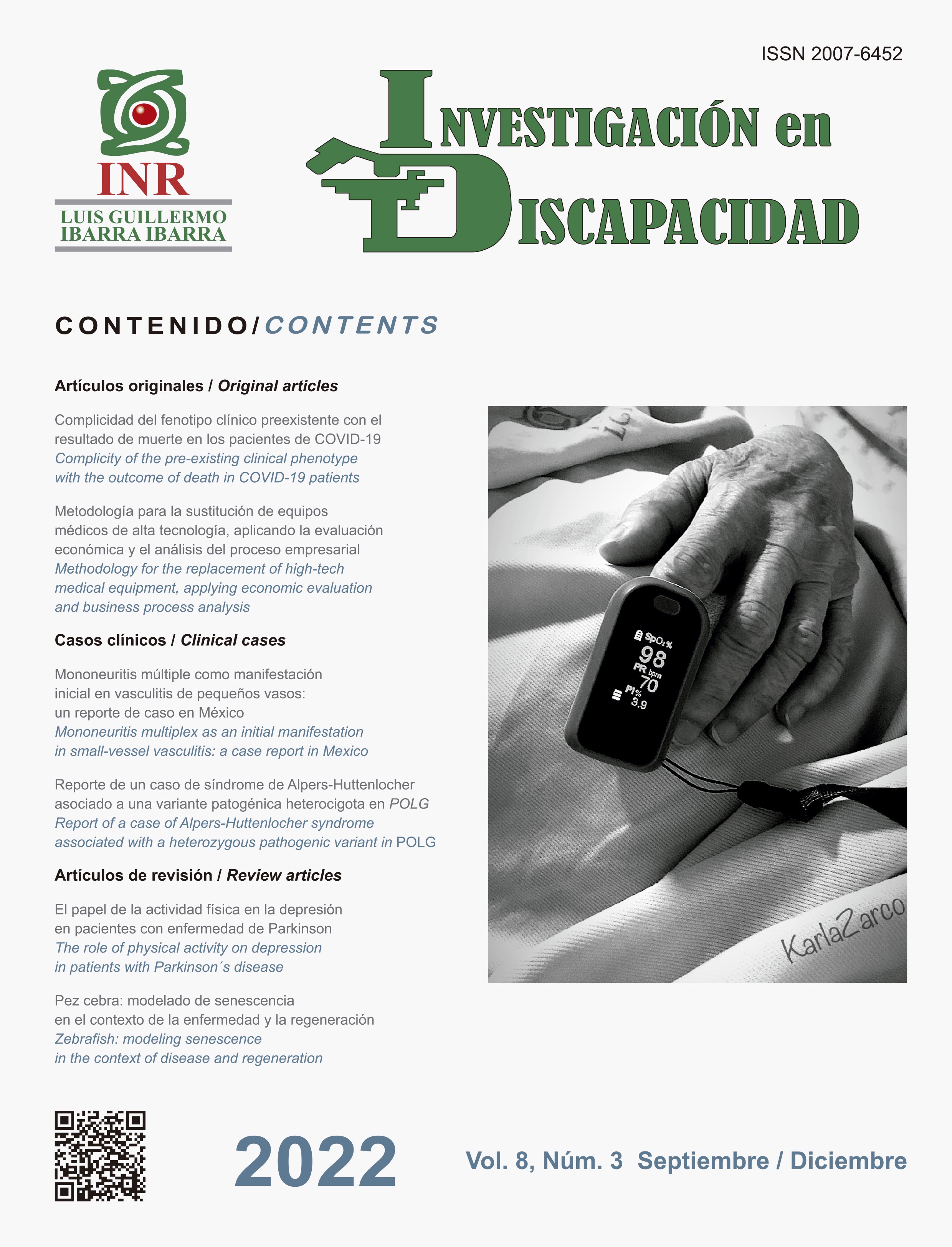El papel de la actividad física en la depresión en pacientes con enfermedad de Parkinson
DOI:
https://doi.org/10.35366/107512Palabras clave:
enfermedad de Parkinson, depresión, actividad física, salud menta, ganglios basalesResumen
La depresión se presenta muy frecuentemente en pacientes con enfermedad de Parkinson (EP), afectando a aproximadamente 50% de ellos. En la actualidad, el tratamiento de este trastorno se basa en la administración de antidepresivos inhibidores selectivos de la recaptura de serotonina. Sin embargo, estos fármacos a menudo pueden llevar a numerosos efectos colaterales que deterioran la calidad de vida de los pacientes. Por lo tanto, es necesario identificar otros tratamientos eficaces y seguros. Existe evidencia de que la práctica de ejercicios físicos reduce la inflamación, mejora el flujo sanguíneo cerebral, aumenta la producción de factores neurotróficos e incrementa el volumen de áreas cerebrales relacionadas con la memoria y la función cognitiva, mejorando el estado de ánimo y algunos aspectos mentales; lo cual puede contrarrestar las alteraciones cerebrales asociadas a trastornos neurodegenerativos y depresión. Bajo esta premisa, se han realizado algunos estudios para determinar si dichos ejercicios pueden mejorar la salud mental en personas
con EP. Particularmente, algunas investigaciones han propuesto ejercicios de resistencia, ejercicios aeróbicos, yoga, baile, enfoques basados en realidad virtual y ejercicios llevados a cabo a través de videojuegos para aminorar los niveles de depresión en dichos pacientes. Por lo tanto, cada vez hay más evidencias que respaldan la utilidad de realizar ejercicios físicos para el tratamiento de la depresión en estos pacientes. El objetivo del presente artículo es presentar evidencia en la literatura internacional para resaltar el potencial terapéutico de efectuar actividad física en el manejo de la depresión en pacientes con EP.
##plugins.generic.pfl.publicationFactsTitle##
##plugins.generic.pfl.reviewerProfiles## N/D
##plugins.generic.pfl.authorStatements##
Indexado: {$indexList}
-
##plugins.generic.pfl.indexedList##
- ##plugins.generic.pfl.academicSociety##
- N/D
Citas
Ascherio A, Schwarzschild MA. The epidemiology of
Parkinson’s disease: risk factors and prevention. Lancet
Neurol. 2016; 15 (12): 1257-1272.
Wirdefeldt K, Adami HO, Cole P, Trichopoulos D, Mandel
J. Epidemiology and etiology of Parkinson’s disease: a
review of the evidence. Eur J Epidemiol. 2011; 26 (1):
-58.
Schapira AH V. Neurobiology and treatment of
Parkinson’s disease. Trends Pharmacol Sci. 2009; 30
(1): 41-47.
Poewe W, Seppi K, Tanner CM, Halliday GM, Brundin
P, Volkmann J, et al. Parkinson disease. Nat Rev Dis
Prim. 2017; 3: 1-21.
Reijnders JSAM, Ehrt U, Weber WEJ, Aarsland D,
Leentjens AFG. A systematic review of prevalence
studies of depression in Parkinson’s disease. Mov
Disord. 2008; 23 (2): 183-189.
Pachana NA, Egan SJ, Laidlaw K, Dissanayaka N, Byrne
GJ, Brockman S, et al. Clinical issues in the treatment of
anxiety and depression in older adults with Parkinson’s
disease. Mov Disord. 2013; 28 (14): 1930-1934.
Ryan M, Eatmon C V, Slevin JT. Drug treatment
strategies for depression in Parkinson disease. Expert
Opin Pharmacother. 2019; 20 (11): 1351-1363.
Skapinakis P, Bakola E, Salanti G, Lewis G, Kyritsis
AP, Mavreas V. Efficacy and acceptability of selective
serotonin reuptake inhibitors for the treatment of
depression in Parkinson’s disease: a systematic review
and meta-analysis of randomized controlled trials. BMC
Neurol. 2010; 10: 49.
de Lima TA, Ferreira-Moraes R, Alves WMG da C,
Alves TGG, Pimentel CP, Sousa EC, et al. Resistance
training reduces depressive symptoms in elderly people
with Parkinson disease: A controlled randomized study.
Scand J Med Sci Sports. 2019; 29 (12): 1957-1967.
Wu PL, Lee M, Huang TT. Effectiveness of physical
activity on patients with depression and Parkinson’s
disease: A systematic review. PLoS One. 2017; 12 (7):
e0181515.
Wu PL, Lee M, Wu SL, Ho HH, Chang MH, Lin HS,
et al. Effects of home-based exercise on motor, nonmotor symptoms and health-related quality of life in
Parkinson’s disease patients: A randomized controlled
trial. Jpn J Nurs Sci. 2021; e12418.
Picelli A, Varalta V, Melotti C, Zatezalo V, Fonte C,
Amato S, et al. Effects of treadmill training on cognitive
and motor features of patients with mild to moderate
Parkinson’s disease: a pilot, single-blind, randomized
controlled trial. Funct Neurol. 2016; 31 (1): 25-31.
Ban M, Yue X, Dou P, Zhang P. The Effects of Yoga
on Patients with Parkinson’s Disease: A Meta-Analysis
of Randomized Controlled Trials. Witt K, editor. Behav
Neurol. 2021; 2021: 5582488.
Wang L li, Sun C jie, Wang Y, Zhan T ting, Yuan J,
Niu CY, et al. Effects of dance therapy on non-motor
symptoms in patients with Parkinson’s disease: a
systematic review and meta-analysis. Aging Clin Exp
Res. 2022; 34 (6): 1201-1208.
Song R, Grabowska W, Park M, Osypiuk K, VergaraDiaz GP, Bonato P, et al. The impact of Tai Chi and
Qigong mind-body exercises on motor and non-motor
function and quality of life in Parkinson’s disease: A
systematic review and meta-analysis. Parkinsonism
Relat Disord. 2017; 41: 3-13.
Dockx K, Bekkers EM, Van den Bergh V, Ginis P,
Rochester L, Hausdorff JM, et al. Virtual reality for
rehabilitation in Parkinson’s disease. Cochrane
database Syst Rev. 2016; 12 (12): CD010760.
Marotta N, Demeco A, Indino A, de Scorpio G,
Moggio L, Ammendolia A. Nintendo Wii(TM) versus
Xbox Kinect(TM) for functional locomotion in people
with Parkinson’s disease: a systematic review and
network meta-analysis. Disabil Rehabil. 2022; 44 (3):
-336.
Altmann LJP, Stegemöller E, Hazamy AA, Wilson
JP, Bowers D, Okun MS, et al. Aerobic Exercise
Improves Mood, Cognition, and Language Function in
Parkinson’s Disease: Results of a Controlled Study. J
Int Neuropsychol Soc. 2016; 22 (9): 878-889.
van der Kolk NM, de Vries NM, Penko AL, van der Vlugt
M, Mulder AA, Post B, et al. A remotely supervised
home-based aerobic exercise programme is feasible
for patients with Parkinson’s disease: results of a
small randomised feasibility trial. J Neurol Neurosurg
Psychiatry. 2018; 89 (9): 1003-1005.
Schmitz-Hübsch T, Pyfer D, Kielwein K, Fimmers R,
Klockgether T, Wüllner U. Qigong exercise for the
symptoms of Parkinson’s disease: A randomized,
controlled pilot study. Mov Disord. 2006; 21 (4): 543-548.
Lee HJ, Kim SY, Chae Y, Kim MY, Yin C, Jung WS, et
al. Turo (Qi Dance) Program for Parkinson’s Disease
Patients: Randomized, Assessor Blind, Waiting-List
Control, Partial Crossover Study. EXPLORE. 2018; 14
(3): 216-223.
Sharma NK, Robbins K, Wagner K, Colgrove YM. A
randomized controlled pilot study of the therapeutic
effects of yoga in people with Parkinson’s disease. Int
J Yoga. 2015; 8 (1): 74-79.
Cheung C, Bhimani R, Wyman JF, Konczak J, Zhang
L, Mishra U, et al. Effects of yoga on oxidative stress,
motor function, and non-motor symptoms in Parkinson’s
disease: a pilot randomized controlled trial. Pilot
feasibility Stud. 2018; 4: 162.
Borrione P, Tranchita E, Sansone P, Parisi A. Effects of
physical activity in Parkinson’s disease: A new tool for
rehabilitation. World J Methodol. 2014; 4 (3): 133-143.
Cugusi L, Solla P, Serpe R, Carzedda T, Piras L,
Oggianu M, et al. Effects of a Nordic Walking program on
motor and non-motor symptoms, functional performance
and body composition in patients with Parkinson’s
disease. NeuroRehabilitation. 2015; 37: 245-254.
Hashimoto H, Takabatake S, Miyaguchi H, Nakanishi H,
Naitou Y. Effects of dance on motor functions, cognitive
functions, and mental symptoms of Parkinson’s disease:
a quasi-randomized pilot trial. Complement Ther Med.
; 23 (2): 210–9.
Lee NY, Lee DK, Song HS. Effect of virtual reality
dance exercise on the balance, activities of daily living,
and depressive disorder status of Parkinson’s disease
patients. J Phys Ther Sci. 2015; 27 (1): 145-147.
Solla P, Cugusi L, Bertoli M, Cereatti A, Della Croce U,
Pani D, et al. Sardinian Folk Dance for Individuals with
Parkinson’s Disease: A Randomized Controlled Pilot
Trial. J Altern Complement Med. 2019; 25 (3): 305-316.
Tollár J, Nagy F, Hortobágyi T. Vastly Different Exercise
Programs Similarly Improve Parkinsonian Symptoms: A
Randomized Clinical Trial. Gerontology. 2019; 65 (2):
-127.
Agudelo LZ, Femenía T, Orhan F, Porsmyr-Palmertz M,
Goiny M, Martinez-Redondo V, et al. Skeletal muscle
PGC-1α1 modulates kynurenine metabolism and
mediates resilience to stress-induced depression. Cell.
; 159 (1): 33-45.
Aarsland D, Påhlhagen S, Ballard CG, Ehrt U,
Svenningsson P. Depression in Parkinson disease--
epidemiology, mechanisms and management. Nat Rev
Neurol. 2011; 8 (1): 35-47.
Berchtold NC, Kesslak JP, Cotman CW. Hippocampal
brain-derived neurotrophic factor gene regulation by
exercise and the medial septum. J Neurosci Res. 2002;
(5): 511-521.
Schaeffer E, Roeben B, Granert O, Hanert A, LiepeltScarfone I, Leks E, et al. Effects of exergaming on
hippocampal volume and brain-derived neurotrophic
factor levels in Parkinson’s disease. Eur J Neurol. 2022;
(2): 441-449.
D’Ascola A, Bruschetta G, Zanghì G, Campo S, Medica
P, Campana S, et al. Changes in plasma 5-HT levels
and equine leukocyte SERT expression in response to
treadmill exercise. Res Vet Sci. 2018; 118: 184-190.
Basso JC, Suzuki WA. The Effects of Acute Exercise on
Mood, Cognition, Neurophysiology, and Neurochemical
Pathways: A Review. Brain Plast. 2017; 2: 127–52.
Speelman AD, van de Warrenburg BP, van Nimwegen
M, Petzinger GM, Munneke M, Bloem BR. How might
physical activity benefit patients with Parkinson disease?
Nat Rev Neurol. 2011; 7 (9): 528-534.
Zoladz JA, Majerczak J, Zeligowska E, Mencel J,
Jaskolski A, Jaskolska A, et al. Moderate-intensity
interval training increases serum brain-derived
neurotrophic factor level and decreases inflammation
in Parkinson’s disease patients. J Physiol Pharmacol
an Off J Polish Physiol Soc. 2014; 65 (3): 441-448.
Descargas
Publicado
Cómo citar
Número
Sección
Licencia
Derechos de autor 2022 Instituto Nacional de Rehabilitación Luis Guillermo Ibarra Ibarra

Esta obra está bajo una licencia internacional Creative Commons Atribución 4.0.
© Instituto Nacional de Rehabilitación Luis Guillermo Ibarra Ibarra under a Creative Commons Attribution 4.0 International (CC BY 4.0) license which allows to reproduce and modify the content if appropiate recognition to the original source is given.




